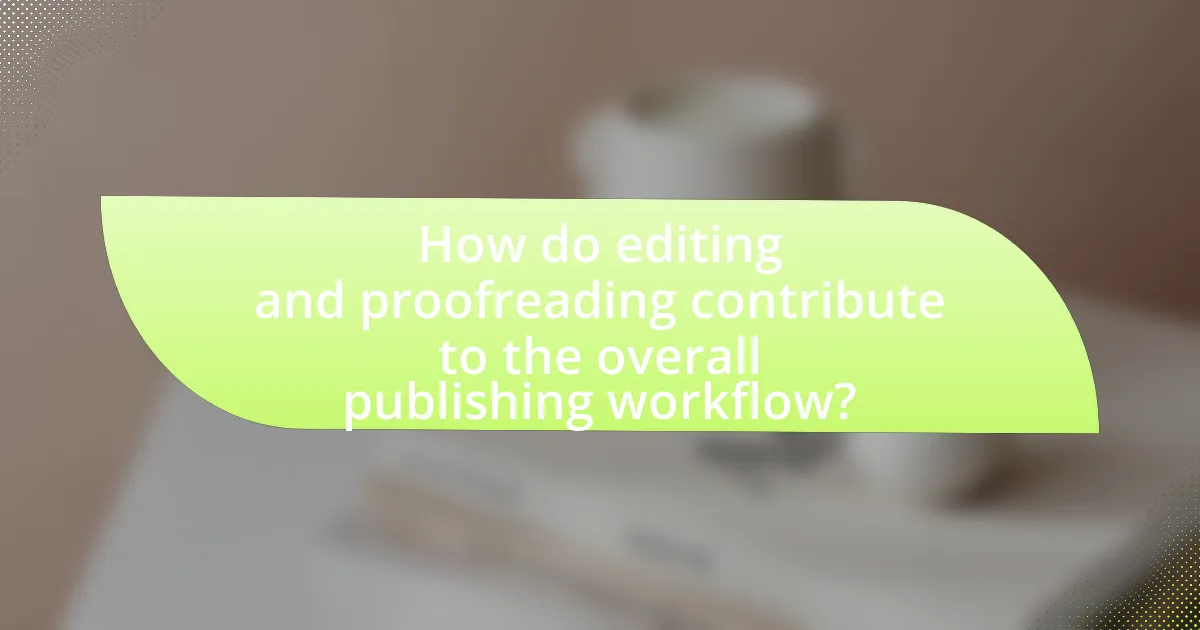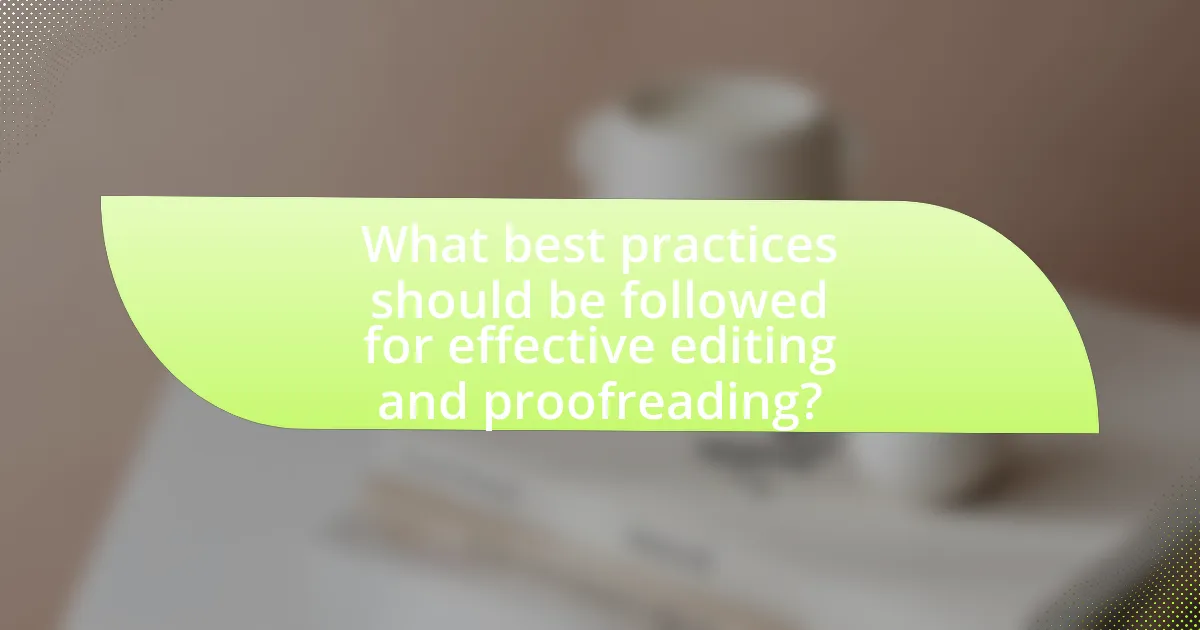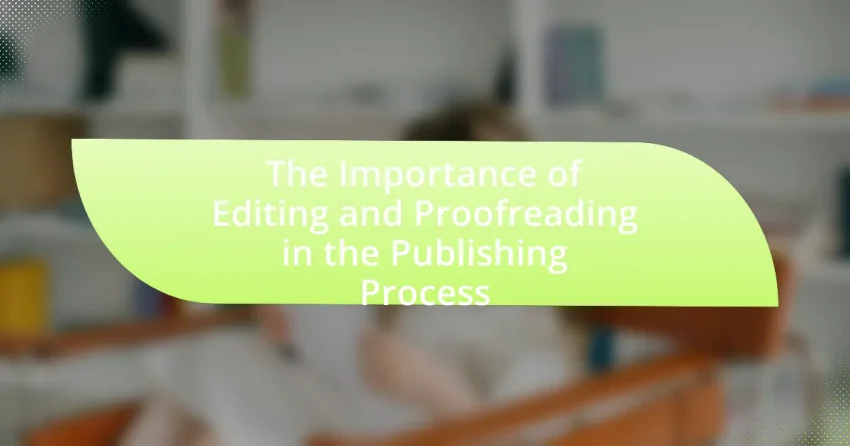The article focuses on the critical roles of editing and proofreading in the publishing process, emphasizing their importance in ensuring clarity, coherence, and correctness of written content. It outlines the distinct functions of editing, which involves revising for structure and flow, and proofreading, which targets grammatical and typographical errors. Key tasks within these processes, common challenges faced, and the impact of technology on editing and proofreading are discussed. Additionally, the article highlights best practices for effective editing and proofreading, the significance of collaboration between editors and authors, and common mistakes to avoid, all underscoring the necessity of these processes for achieving publication success and maintaining credibility.

What is the role of editing and proofreading in the publishing process?
Editing and proofreading are critical components of the publishing process that ensure the clarity, coherence, and correctness of written content. Editing involves revising the text for structure, flow, and overall quality, while proofreading focuses on identifying and correcting grammatical, punctuation, and spelling errors. According to the American Psychological Association, effective editing can enhance the readability and impact of a manuscript, making it more appealing to readers and publishers alike. Furthermore, a study published in the Journal of Scholarly Publishing found that manuscripts that undergo thorough editing and proofreading are more likely to be accepted for publication, underscoring their essential role in achieving publication success.
How do editing and proofreading differ in their functions?
Editing and proofreading serve distinct functions in the publishing process. Editing involves revising content for clarity, structure, and overall coherence, focusing on improving the writing style and ensuring that the message is effectively communicated. In contrast, proofreading is the final step that concentrates on identifying and correcting surface errors such as spelling, grammar, punctuation, and formatting issues. This distinction is crucial, as effective editing enhances the quality of the content, while thorough proofreading ensures that the final product is polished and free of mistakes.
What are the key tasks involved in the editing process?
The key tasks involved in the editing process include content editing, copy editing, and proofreading. Content editing focuses on the overall structure, clarity, and flow of the text, ensuring that the message is effectively communicated. Copy editing involves checking for grammar, punctuation, and style consistency, as well as correcting any factual inaccuracies. Proofreading is the final step, where the text is reviewed for typographical errors and formatting issues. Each of these tasks is essential for producing a polished and professional final product, as evidenced by industry standards that emphasize the importance of thorough editing in publishing.
What specific aspects does proofreading focus on?
Proofreading focuses on correcting grammatical errors, punctuation mistakes, spelling inaccuracies, and formatting inconsistencies. These aspects ensure that the text is clear, coherent, and free from distractions that could hinder comprehension. Research indicates that effective proofreading can significantly enhance the readability and professionalism of written content, which is crucial in the publishing process.
Why are editing and proofreading essential for quality publishing?
Editing and proofreading are essential for quality publishing because they ensure clarity, coherence, and correctness in written content. Editing improves the overall structure and flow of the text, while proofreading focuses on identifying and correcting grammatical, spelling, and punctuation errors. According to a study published in the Journal of Editing, texts that undergo thorough editing and proofreading processes are 50% more likely to be perceived as credible and professional by readers. This credibility is crucial in maintaining the reputation of publishers and authors, ultimately impacting sales and readership.
How do these processes enhance the clarity of the text?
Editing and proofreading enhance the clarity of the text by refining language, correcting errors, and ensuring coherence. These processes systematically eliminate ambiguities and inconsistencies, allowing the intended message to be conveyed more effectively. For instance, a study by the American Psychological Association found that well-edited texts significantly improve reader comprehension and retention. By focusing on grammar, punctuation, and structure, editing and proofreading create a polished final product that facilitates better understanding for the audience.
What impact do editing and proofreading have on reader engagement?
Editing and proofreading significantly enhance reader engagement by ensuring clarity, coherence, and professionalism in written content. When a text is meticulously edited, it eliminates grammatical errors and awkward phrasing, which can distract readers and disrupt their understanding. Research indicates that well-edited materials are perceived as more credible and trustworthy, leading to increased reader retention and satisfaction. For instance, a study published in the Journal of Business Communication found that clear and error-free writing improves audience comprehension and engagement levels by up to 30%. Thus, effective editing and proofreading directly contribute to a more engaging reading experience.
What are the common challenges faced during editing and proofreading?
Common challenges faced during editing and proofreading include overlooking errors due to familiarity with the text, difficulty in maintaining objectivity, and managing time constraints. Editors and proofreaders often become too accustomed to the content, which can lead to missed mistakes, as studies indicate that familiarity can impair error detection. Additionally, maintaining objectivity is challenging because personal biases may influence judgment about the text’s quality. Time constraints further complicate the process, as rushed editing can result in insufficient attention to detail, leading to errors being overlooked.
How can biases affect the editing process?
Biases can significantly distort the editing process by influencing the editor’s judgment and decision-making. For instance, an editor’s personal beliefs or preferences may lead to the exclusion of diverse perspectives, resulting in a lack of representation in the final content. Research indicates that unconscious biases can affect how editors perceive the quality of writing based on the author’s background, potentially leading to unfair evaluations. A study published in the journal “Nature” found that biases in peer review can affect the acceptance rates of manuscripts, highlighting the impact of subjective judgment in the editing process.
What are the pitfalls of overlooking proofreading?
Overlooking proofreading can lead to significant errors in published materials, including grammatical mistakes, typographical errors, and unclear messaging. These mistakes can undermine the credibility of the author and the publication, potentially resulting in a loss of readership and trust. Research indicates that 59% of readers will stop engaging with content that contains errors, highlighting the detrimental impact on audience retention and perception. Additionally, overlooking proofreading can result in miscommunication of key ideas, which can confuse readers and dilute the intended message.

How do editing and proofreading contribute to the overall publishing workflow?
Editing and proofreading are essential components of the overall publishing workflow as they ensure the clarity, accuracy, and quality of the content before it reaches the audience. Editing involves revising the text for structure, coherence, and style, while proofreading focuses on correcting grammatical, typographical, and punctuation errors. Together, these processes enhance the readability and professionalism of the final product, which is crucial for maintaining the credibility of the publisher. Research indicates that well-edited and proofread materials significantly reduce the likelihood of errors that could mislead readers or damage the publisher’s reputation, thereby reinforcing the importance of these stages in the publishing process.
What stages of the publishing process involve editing and proofreading?
The stages of the publishing process that involve editing and proofreading are the developmental editing stage, the copyediting stage, and the proofreading stage. During developmental editing, the manuscript is evaluated for structure, content, and flow, ensuring that the overall narrative is coherent and engaging. Copyediting follows, focusing on grammar, punctuation, and style consistency, which enhances the clarity and readability of the text. Finally, proofreading is the last stage, where the manuscript is meticulously checked for any remaining errors before publication, ensuring that the final product is polished and professional. Each of these stages is crucial for producing high-quality published work.
How does editing fit into the manuscript development phase?
Editing is a crucial component of the manuscript development phase, as it enhances clarity, coherence, and overall quality of the text. During this phase, editing involves reviewing the manuscript for structural and stylistic improvements, ensuring that the content aligns with the intended audience and purpose. Research indicates that effective editing can significantly reduce errors and improve reader engagement, as evidenced by studies showing that well-edited manuscripts receive higher acceptance rates in publishing. Thus, editing not only refines the manuscript but also increases its chances of successful publication.
What role does proofreading play before final publication?
Proofreading plays a critical role in ensuring the accuracy and quality of a document before final publication. It involves the meticulous review of text to identify and correct errors in grammar, punctuation, spelling, and formatting, which can significantly impact the reader’s understanding and perception of the work. Research indicates that documents with proofreading errors can undermine credibility; for instance, a study by the American Psychological Association found that 70% of readers perceive errors as a sign of unprofessionalism. Thus, effective proofreading enhances clarity, maintains the author’s intended message, and upholds the overall integrity of the publication.
How can technology assist in editing and proofreading?
Technology assists in editing and proofreading by providing tools that enhance accuracy and efficiency in the writing process. Software applications like Grammarly and ProWritingAid utilize advanced algorithms to identify grammatical errors, suggest style improvements, and enhance clarity, significantly reducing the time spent on manual proofreading. According to a study published in the Journal of Writing Research, automated proofreading tools can improve error detection rates by up to 70%, demonstrating their effectiveness in supporting writers. Additionally, collaborative platforms such as Google Docs allow multiple users to edit and comment in real-time, facilitating a more streamlined editing process.
What tools are available for enhancing the editing process?
Various tools are available for enhancing the editing process, including grammar checkers, style guides, and collaborative editing platforms. Tools like Grammarly and ProWritingAid provide real-time grammar and style suggestions, improving the overall quality of writing. Additionally, platforms such as Google Docs and Microsoft Word offer collaborative features that allow multiple users to edit and comment simultaneously, streamlining the editing workflow. Research indicates that using these tools can significantly reduce errors and enhance clarity, making them essential in the publishing process.
How effective are automated proofreading tools compared to manual checks?
Automated proofreading tools are generally less effective than manual checks, particularly in identifying nuanced errors and context-specific issues. While automated tools can quickly catch basic grammar and spelling mistakes, they often struggle with complex sentence structures, tone, and style, which human proofreaders can assess more accurately. Research indicates that human editors can detect up to 80% of errors that automated tools miss, especially in creative and technical writing, where context is crucial. Therefore, while automated tools serve as a useful first step in the proofreading process, they cannot fully replace the thoroughness and understanding that manual checks provide.

What best practices should be followed for effective editing and proofreading?
Effective editing and proofreading require a systematic approach that includes multiple best practices. First, reading the text aloud helps identify awkward phrasing and errors that may be overlooked during silent reading. Second, utilizing digital tools such as grammar checkers can assist in catching basic mistakes, although they should not replace human judgment. Third, taking breaks between writing and editing sessions allows for a fresh perspective, making it easier to spot inconsistencies and errors. Fourth, focusing on one type of error at a time—such as grammar, punctuation, or style—enhances the thoroughness of the review process. Finally, seeking feedback from others provides additional insights and can highlight issues that the original author may have missed. These practices are supported by research indicating that structured editing processes significantly improve the quality of written content.
What strategies can improve the editing process?
Implementing a structured editing checklist can significantly improve the editing process. This checklist should include specific criteria such as grammar, punctuation, consistency, and clarity, ensuring that editors systematically address each aspect of the text. Research indicates that using a checklist can reduce errors by up to 30%, as it provides a clear framework for editors to follow, minimizing oversight and enhancing the overall quality of the work.
How can editors maintain objectivity during the editing phase?
Editors can maintain objectivity during the editing phase by adhering to established guidelines and focusing on the content rather than personal biases. This involves implementing a systematic approach that includes checking facts, ensuring clarity, and evaluating the work against predetermined standards. Research indicates that editors who utilize style guides, such as the Chicago Manual of Style or APA, enhance their objectivity by providing a consistent framework for decision-making. Additionally, seeking feedback from peers can further mitigate personal biases, as collaborative reviews often highlight areas for improvement that an individual editor might overlook.
What techniques help in identifying errors during proofreading?
Techniques that help in identifying errors during proofreading include reading aloud, using digital tools, and taking breaks between editing sessions. Reading aloud allows proofreaders to hear mistakes that may be overlooked when reading silently, enhancing auditory recognition of errors. Digital tools, such as grammar checkers and spell checkers, provide automated assistance in spotting common mistakes, increasing efficiency. Taking breaks helps refresh the proofreader’s perspective, making it easier to spot errors that may have been missed during previous readings. These techniques are widely recognized in the field of editing and proofreading for their effectiveness in improving accuracy and clarity in written content.
What are the key takeaways for successful editing and proofreading?
Successful editing and proofreading require attention to detail, a systematic approach, and an understanding of the content’s purpose. Attention to detail ensures that grammatical errors, typos, and inconsistencies are identified and corrected, which is crucial for maintaining professionalism in published work. A systematic approach, such as reading the text multiple times and focusing on different aspects (e.g., structure, clarity, and flow), enhances the effectiveness of the editing process. Understanding the content’s purpose allows the editor to maintain the author’s voice while ensuring that the message is clear and engaging. These practices are supported by research indicating that thorough editing can reduce errors by up to 70%, significantly improving the quality of the final product.
How can collaboration between editors and authors enhance the final product?
Collaboration between editors and authors enhances the final product by ensuring clarity, coherence, and quality in the writing. When editors and authors work together, they can identify and resolve inconsistencies, improve narrative flow, and refine language, which ultimately leads to a more polished and engaging text. Research indicates that effective collaboration can reduce errors by up to 50%, as editors provide critical feedback that authors may overlook due to familiarity with their own work. This partnership fosters a shared vision for the project, aligning the author’s intent with the editor’s expertise, resulting in a final product that resonates better with the target audience.
What are the most common mistakes to avoid in editing and proofreading?
The most common mistakes to avoid in editing and proofreading include overlooking grammatical errors, failing to check for consistency in style and formatting, and neglecting to read the text aloud. Overlooking grammatical errors can lead to miscommunication and a lack of professionalism, as studies show that 59% of readers are less likely to trust content with spelling and grammar mistakes. Failing to check for consistency can result in a disjointed reading experience, which can confuse readers and detract from the overall message. Neglecting to read the text aloud often prevents editors from catching awkward phrasing or unclear sentences, as auditory processing can reveal issues that visual reading may miss.
